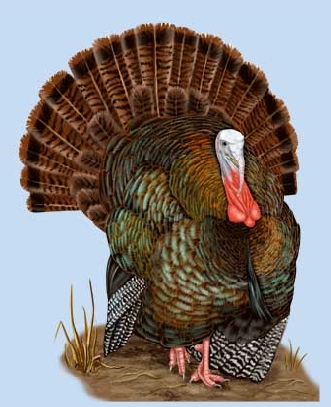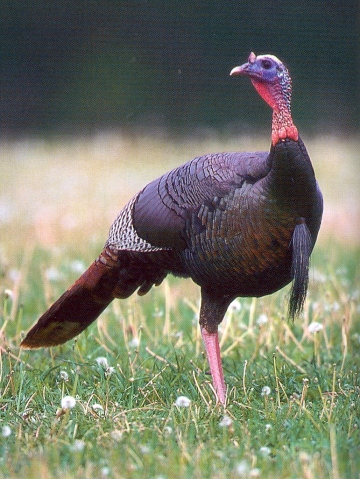|

Large, ground-walking bird, iridescent dark brown overall
with black and green bars, small, featherless, blue head that changes
color according to mood, and red throat wattles. Breast beard (modified
feathers) is black. The legs have spurs.
It is the largest game bird in
North America.

|
WILD
TURKEY
Meleagris gallopavo
GALLIFORMES
Turkeys and Grouse (Phasianidae)
Range and Habitat
Resident in much of the southern U.S. from Arizona east, as far north
as New England. Introduced to many western states, including California.
Inhabits oak and pine forests; young birds need open area where they
can forage for insects.
SOUND: "cluk, cluk, cut, putt"
The Wild Turkey is one of only two domesticated birds originating in
the New World. The other is the Muscovy Duck. European explorers took
them to Europe from Mexico in the early 1500s. They were so successfully
domesticated there that English colonists brought them back with them
when they settled on the Atlantic Coast.
The range and numbers of Wild Turkeys had decreased in the early 1900s’
due to hunting and loss of habitat. Game managers believe their numbers
were as low as 30,000. Current estimates place their population at over
7 million.
The idea that Benjamin Franklin preferred the Turkey as the national
bird of the United States comes from a letter he wrote to his daughter
in 1784. He criticized the choice of the Eagle as the national bird
and suggested that a Turkey would have made a better alternative.
A group of turkeys has many collective nouns, including a "crop",
"dole", "gang", "posse", and "raffle"
of turkeys.
The Wild Turkey has a large global range reaching up to generally 4
million kilometers. This bird can be found in Canada, Mexico and the
United States. It also has vagrant populations in Australia and New
Zealand as well.
This bird dwells in a diversity of environments including forests, savanna,
shrubland, grassland and pasturelands. The global population of this
bird is estimated to be around 1.3 million individual birds. Currently,
it is not believed that the population trends for this species will
soon approach the minimum levels that could suggest a potential decline
in population.

|